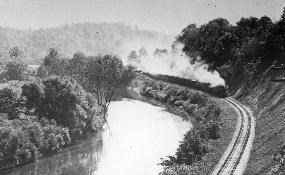
Courtesy / Bath Township Historical Society Around the world, farmers share a special bond with their land that involves faith and stewardship. Beginning with Indigenous peoples 1,500 years ago, generations of Cuyahoga Valley farmers from diverse backgrounds have raised the crops and livestock necessary for survival. 
NPS Collection Throughout the last 200 years, both agriculture and the landscape significantly changed as cultural influences brought new ideas and technology to the Cuyahoga Valley. Farming greatly expanded during the Canal Era (1827 - 1850) because this interstate system gave farmers access to new markets. The Ohio & Erie Canal and later the railroads were important forces that helped subsistence farmers play a larger role in the market-driven economy. The canal also influenced the development of farm-related industries, such as cheese factories and grist mills.
Managing a successful farm involves making daily decisions about what products to grow, how to sell those goods, and how to overcome numerous challenges. Click the links below to learn about how past and present farmers made their living in the Cuyahoga Valley.
Click on the links to discover more: |
Last updated: November 9, 2021
